External links
- (in Romanian) Official site
Zimnicea High School (Romanian : Liceul Teoretic Zimnicea) is a high school located in central Zimnicea, Teleorman County, Romania. Its current building opened in December 1977, the previous location having been destroyed in the March earthquake. It was built with funds from the government of Switzerland.
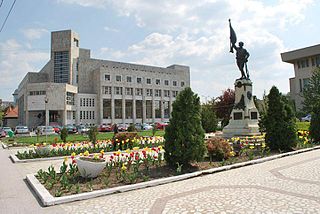
Alexandria is the capital city of the Teleorman County, Muntenia, Romania. It is located south-west of Bucharest, towards the Bulgarian border, and has over 40,000 inhabitants. The 44th parallel north passes just north of the city.

With an area of 238,397 km2 (92,046 sq mi), Romania is the twelfth-largest country in Europe. It is a Balkan country located at the crossroads of Central, Eastern and Southeast Europe. It's bordered on the Black Sea, the country is halfway between the equator and the North Pole and equidistant from the westernmost part of Europe—the Atlantic Coast—and the most easterly—the Ural Mountains. Romania has 3,195 kilometres (1,985 mi) of border. Republic of Moldova and Ukraine lies to the east, Bulgaria lies to the south, and Serbia and Hungary to the west. In the southeast, 245 kilometres (152 mi) of sea coastline provide an important outlet to the Black Sea and the Atlantic Ocean.

Teleorman County is a county (județ) of Romania on the border with Bulgaria, in the historical region Muntenia, with its capital city at Alexandria.

Zimnicea is a town in Teleorman County, Romania, a port on the Danube opposite the Bulgarian city of Svishtov.
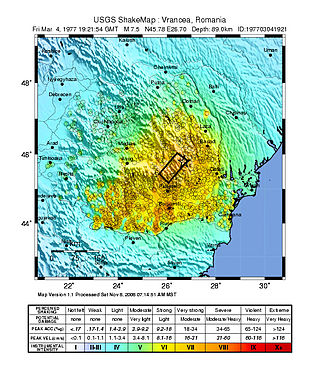
The 1977 Vrancea earthquake occurred on 4 March 1977, at 21:22 local time, and was felt throughout the Balkans. It had a magnitude of 7.5, making it the second most powerful earthquake recorded in Romania in the 20th century, after the 10 November 1940 seismic event. The hypocenter was situated in the Vrancea Mountains, the most seismically active part of Romania, at a depth of 85.3 km.

Svishtov is a town in northern Bulgaria, located in Veliko Tarnovo Province on the right bank of the Danube river opposite the Romanian town of Zimnicea. It is the administrative centre of the homonymous Svishtov Municipality. The town is the second-largest in the province after the city of Veliko Tarnovo and before Gorna Oryahovitsa.

Roșiorii de Vede is a city in Teleorman County, Romania. Located in the Muntenia region, it is one of the oldest cities in the country. It was first mentioned in a document which dates back to 1385, when the city was visited by two German pilgrims who were returning from Jerusalem and stopped for a few days in a town they called Russenart.

Pieve Emanuele is a comune (municipality) in the Italian region of Lombardy, located about 13 kilometres (8 mi) south of Milan, and about 20 kilometres (12 mi) north of Pavia.
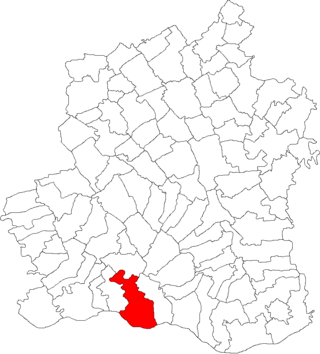
Seaca is a commune in Teleorman County, Muntenia, Romania, about 15 km east of Turnu Măgurele and 10 km north of the Danube River. Its population is about 2,500 people. It is composed of two villages, Năvodari and Seaca. The majority of people speak Romanian, with some speaking a form of the Romani language. A sizable part of the residents are landowners. The main crops planted are grains such as wheat, corn, and to a smaller degree rice. A smaller percentage of the residents work in nearby cities, mainly in Turnu Măgurele and to a lesser degree in Alexandria.
Regiunea București was one of the newly established administrative divisions of the People's Republic of Romania, copied after the Soviet style of territorial organization.
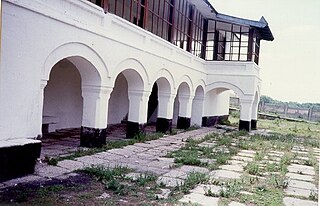
Ștorobăneasa is a commune in the southern part of Teleorman County, Muntenia, Romania, on the left side of the Teleorman River. The commune has 3,101 inhabitants and a surface of 352.8 ha within the built-up area. It is composed of two villages, Beiu and Ștorobăneasa.

Poroschia is a commune in Teleorman County, Muntenia, Romania. It is composed of two villages, Calomfirești and Poroschia.
Găujani is a commune located in Giurgiu County, Muntenia, Romania. It is composed of three villages: Cetățuia, Găujani, and Pietrișu.

Acidava (Acidaua) was a Dacian and later Roman fortress on the Olt river near the lower Danube. The settlements remains are located in today's Enoşeşti, Olt County, Oltenia, Romania.
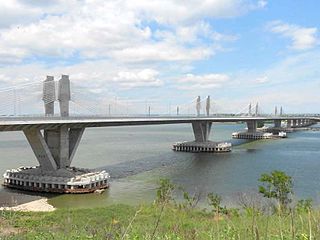
The Bulgaria–Romania border is the state border between Bulgaria and Romania.
Florea Opriș in Zimnicea, is a former Romanian rugby union football player, referee and currently coach. He played as prop, as well as flanker.
The Pasărea is a left tributary of the river Danube in Romania. It discharges into the Danube in Zimnicea. Its length is 19 km (12 mi) and its basin size is 191 km2 (74 sq mi).

Nicolae Giosan was a Romanian agricultural engineer and communist politician.